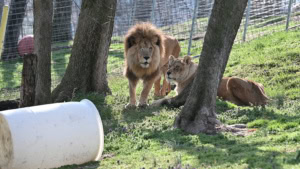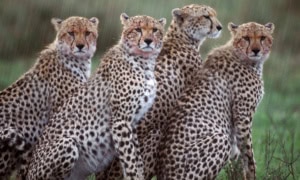Visitors might find it strange that so many of our cats live by themselves. To species as social as humans, it might be difficult to imagine living our entire life in solitude. But to many carnivores, and cats in particular, this is normal behavior.
Different animals have different social structures, ranging from the highly social clans of spotted hyenas to the nearly complete solitude of tigers. This is dependent on several factors, but ultimately boils down to one in particular: advantage in survival. For more social animals, the advantages of living in groups – namely, the ability to work together while hunting, defending territory and raising offspring – outweigh the disadvantages of disease and higher possibility of conflict. For solitary animals, however, these risks outweigh the advantages.

Lions
When people hear the term “social cat,” the image that immediately comes to mind is usually a lion. And it’s no wonder, since lions are the only social species of big cat. They live in groups called prides, which are made of roughly a dozen females, their cubs, and three or so males.
The female lions of a pride are usually related, although sometimes a female will join from a different pride. They tend to synchronize the births of their cubs in order to help raise one another’s offspring. Although they prioritize their own offspring above those of others, they often readily help take care of the cubs of close relatives. Females work together to both scavenge and hunt for food, and are the primary hunters.
Once the cubs reach about two or three years of age, they become adolescents. Most females at this age will remain with their birth pride, although that is not always the case. The males will either leave on their own or be kicked out. They often stick with one another in small groups called coalitions, which are usually made of siblings or cousins.
This coalition of males will eventually attempt to take over another pride’s territory. If successful, they will become the new protectors of the pride against threats – other males, spotted hyenas, African wild dogs, etc. They will father more cubs in the pride, before eventually being kicked out by a new, younger coalition.

Cheetahs
Believe it or not, cheetahs are another cat with a social structure. Cheetah cubs remain with their mother for the first eighteen months, after which they will leave her. They remain together until they’re around two years old, and then the females go off on their own. Female cheetahs tend to keep territories close to their mothers’, and may even overlap territory when prey is scarce, but when not raising cubs they will lead solitary lives. Males, on the other hand, remain in coalitions with their brothers for lifetime.
Because most cats are naturally solitary, they don’t necessarily mind having a habitat to themselves – in fact, many prefer it! Big cats especially are not introduced to a cat they have not previously lived with, to attempt to minimize territory disputes.
Sources
Figure 2: https://cheetah.org/learn/about-cheetahs/
https://wolfcenter.org/why-are-some-carnivores-solitary/
https://www.four-paws.org/campaigns-topics/topics/help-for-big-cats/big-cats-way-of-life-behaviour
https://www.pbs.org/articles/big-cats-24-7-what-is-a-lion-pride-and-how-does-it-work
https://www.lionstigersandbears.org/lions-and-their-unbreakable-bond-with-their-prides/?gad_source=1&gad_campaignid=20572958767&gbraid=0AAAAADrfe_DHDFHjW_hKvgTbYCNX2IckQ&gclid=Cj0KCQjw8KrFBhDUARIsAMvIApaYS2RTuHk4AYLP_3_By8fK-tsIwEsyVNeXPEGGJgI_KuKH0vsgm3kaAgJmEALw_wcB
https://nationalzoo.si.edu/animals/cheetah
*Published by Eryn Meeker on 09/20/2025*